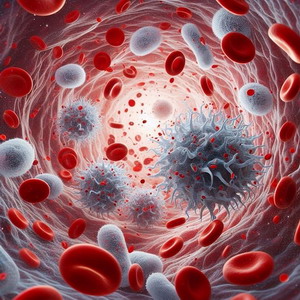Cortisol is famously known as the stress hormone. I hav e listened to many lectures about the dangers of high cortisol. I have special supplements that are designed to bring down high cortisol levels. Cortisol has become one of the major alternative health boogymen to be fought on our perpetual quest for perfect health. And yet, something about this story never made sense to me. In the short term cortisol is anti-inflammatory. When you are injured and your body has just experienced a high-stress situation, cortisol is released after the emergency is over to start the healing process. Why is it that chronic stress raises cortisol chronically and then it supposedly becomes inflammatory? I have a couple of patients who have had pituitary tumors removed which eliminated their ability even to form cortisol. They have to be on a constant dose of cortisone (the drug version of cortisol) their whole life. They do not have the issues I have been warned about that chronic excess cortisol is supposed to produce. How does that work out? e listened to many lectures about the dangers of high cortisol. I have special supplements that are designed to bring down high cortisol levels. Cortisol has become one of the major alternative health boogymen to be fought on our perpetual quest for perfect health. And yet, something about this story never made sense to me. In the short term cortisol is anti-inflammatory. When you are injured and your body has just experienced a high-stress situation, cortisol is released after the emergency is over to start the healing process. Why is it that chronic stress raises cortisol chronically and then it supposedly becomes inflammatory? I have a couple of patients who have had pituitary tumors removed which eliminated their ability even to form cortisol. They have to be on a constant dose of cortisone (the drug version of cortisol) their whole life. They do not have the issues I have been warned about that chronic excess cortisol is supposed to produce. How does that work out?
Well, last week I finally listened to a lecture that flipped the cortisol story on its head in a way that now things ma ke sense. Cortisol is the stress hormone in the sense that when you have experienced significant stress, it is released after the stress episode is past to bring you down back to normal. Cortisol is anti-inflammatory. That is why we use cortisone cream on skin rashes or take hydrocortisone as a pill to help us fight severe internal inflammation. Since this is all true, why do health practitioners associate high cortisol levels with chronic disease and excess inflammation? The answer is simple, they are seeing patients who present with various chronic diseases and want to find the underlying causes behind these diseases. After they do a bunch of lab tests, low and behold, high cortisol levels show up! The natural assumption is that anything outside the normal ranges on a lab test indicates where the problem is. ke sense. Cortisol is the stress hormone in the sense that when you have experienced significant stress, it is released after the stress episode is past to bring you down back to normal. Cortisol is anti-inflammatory. That is why we use cortisone cream on skin rashes or take hydrocortisone as a pill to help us fight severe internal inflammation. Since this is all true, why do health practitioners associate high cortisol levels with chronic disease and excess inflammation? The answer is simple, they are seeing patients who present with various chronic diseases and want to find the underlying causes behind these diseases. After they do a bunch of lab tests, low and behold, high cortisol levels show up! The natural assumption is that anything outside the normal ranges on a lab test indicates where the problem is.
We see the exact same story for blood fats like cholesterol. When a person has arteries clogging up with atherosclerosi s which is made partially from cholesterol and we do lab work that shows the patient’s cholesterol levels are much higher than normal then we assume we have found the problem. Solve the high lab values and you will solve the health problem. Right? Except this is not how it works. What modern medicine misses is that those out-of-range lab values on the blood tests are just more symptoms. The real cause has not been found. The real causes are complex and subtle and can’t be found by drawing blood at your friendly neighborhood Quest or Lab Corp. s which is made partially from cholesterol and we do lab work that shows the patient’s cholesterol levels are much higher than normal then we assume we have found the problem. Solve the high lab values and you will solve the health problem. Right? Except this is not how it works. What modern medicine misses is that those out-of-range lab values on the blood tests are just more symptoms. The real cause has not been found. The real causes are complex and subtle and can’t be found by drawing blood at your friendly neighborhood Quest or Lab Corp.
Now that is not to say that what is going on is not understood by research scientists, because oftentimes it is. However , researchers love to spend years and years arguing with each other and repeating experiments over and over to figure out which of them is right. (This game is what keeps them employed so they can pay their mortgages and send their kids to college.) So research knowledge is bounced around for 20 to 40 years before a consensus is reached and the knowledge is put into textbooks so medical students can learn it. Doctors are human and they will tend to practice what they learned in school until they retire. So if your doctor has been in practice for 20 years, he/she will be using knowledge that is 40 to 60 years old. The only education doctors get to update their knowledge is what is presented to them by pharmaceutical companies pushing their latest drug solutions. , researchers love to spend years and years arguing with each other and repeating experiments over and over to figure out which of them is right. (This game is what keeps them employed so they can pay their mortgages and send their kids to college.) So research knowledge is bounced around for 20 to 40 years before a consensus is reached and the knowledge is put into textbooks so medical students can learn it. Doctors are human and they will tend to practice what they learned in school until they retire. So if your doctor has been in practice for 20 years, he/she will be using knowledge that is 40 to 60 years old. The only education doctors get to update their knowledge is what is presented to them by pharmaceutical companies pushing their latest drug solutions.
Over the last 30 years, a lot of much deeper knowledge has been revealed about how things work in our cells and ins ide our cells. I remember first learning about receptor site sensitivity in nerve cells to neurotransmitters from one of the most prominent researchers in nerve cell biology almost 25 years ago. Back then this was brand new research. I don’t think this stuff has even made it into medical textbooks today. What has made it is the understanding that cells in the body that should respond to insulin for regulating blood sugar, will become resistant to the insulin. They just stop listening. Their receptor sites go away so there are not enough places for insulin to attach to trigger the cells to let sugar into the cells. The story with cortisol follows along the same line of research. ide our cells. I remember first learning about receptor site sensitivity in nerve cells to neurotransmitters from one of the most prominent researchers in nerve cell biology almost 25 years ago. Back then this was brand new research. I don’t think this stuff has even made it into medical textbooks today. What has made it is the understanding that cells in the body that should respond to insulin for regulating blood sugar, will become resistant to the insulin. They just stop listening. Their receptor sites go away so there are not enough places for insulin to attach to trigger the cells to let sugar into the cells. The story with cortisol follows along the same line of research.
Let’s describe the cortisol story. It starts with something
 scaring you. Your body goes into the fight or flight mode. What that means is that your brain sends a message to your adrenal glands to pump out a surge of adrenaline. Adrenaline immediately supercharges your muscle energy production and opens up blood flow to those muscles. It increases your vision, hearing, smell, mental processing, speed, and strength. At the same time, it shuts down your digestion. Your heart pumps faster and harder driving up your blood pressure. Blood vessels to your muscles and lungs open up, but close down those going to your internal organs and skin. Chemically, adrenaline makes your system run hot, which produces a lot of free radicals that burn your tissues. Hint, this is what causes the symptoms that are associated with high cortisol. scaring you. Your body goes into the fight or flight mode. What that means is that your brain sends a message to your adrenal glands to pump out a surge of adrenaline. Adrenaline immediately supercharges your muscle energy production and opens up blood flow to those muscles. It increases your vision, hearing, smell, mental processing, speed, and strength. At the same time, it shuts down your digestion. Your heart pumps faster and harder driving up your blood pressure. Blood vessels to your muscles and lungs open up, but close down those going to your internal organs and skin. Chemically, adrenaline makes your system run hot, which produces a lot of free radicals that burn your tissues. Hint, this is what causes the symptoms that are associated with high cortisol.
We are only designed to do this type of high-energy adren aline boost for a few minutes – enough time to either kill your threat or run away from it. Since you have just burnt your tissues, your body automatically starts medicating you with self-made cortisone (cortisol). This is just like how you might put cortisone cream on a skin burn to soothe the inflammation. But modern life does not generally allow us to kill our threats, nor are we able to just run away from them. Modern life has us manage these threats day to day without a real resolution. That means that our adrenaline levels are always being pumped up. Naturally, that drives up our cortisol levels to compensate. The body is not chemically wired to deal with cortisol surges that frequently, and the cells start removing the receptor sites in their outer membranes that respond to cortisol. We get cortisol resistance. Consequently, our adrenals keep pumping out more cortisol trying to get a response, and before you know it we have chronically high cortisol levels. aline boost for a few minutes – enough time to either kill your threat or run away from it. Since you have just burnt your tissues, your body automatically starts medicating you with self-made cortisone (cortisol). This is just like how you might put cortisone cream on a skin burn to soothe the inflammation. But modern life does not generally allow us to kill our threats, nor are we able to just run away from them. Modern life has us manage these threats day to day without a real resolution. That means that our adrenaline levels are always being pumped up. Naturally, that drives up our cortisol levels to compensate. The body is not chemically wired to deal with cortisol surges that frequently, and the cells start removing the receptor sites in their outer membranes that respond to cortisol. We get cortisol resistance. Consequently, our adrenals keep pumping out more cortisol trying to get a response, and before you know it we have chronically high cortisol levels.
So why do we blame cortisol instead of the real culpri t — adrenaline? This is because of the lab work situation. We can easily measure cortisol in our blood and saliva because it lasts a long time in the bloodstream. We can not do this for adrenaline as it is a very fast-acting chemical that is cleared from circulation very quickly. I have never seen a lab test for adrenaline. Since there are no simple lab tests for adrenaline, it is off everybody’s radar. Doctors want to tackle something that they can measure, give medication for, and then show how well they are doing at controlling the issue. Telling a patient their adrenaline is too high is like telling them they are possessed by evil spirits. The feeling is that if you can’t measure it then it does not exist. We could use cortisol levels as a proxy for how well we are doing at reducing our adrenaline levels, but instead, we somehow decided that cortisol was the problem and we needed to lower the cortisol without addressing the underlying adrenaline problem. t — adrenaline? This is because of the lab work situation. We can easily measure cortisol in our blood and saliva because it lasts a long time in the bloodstream. We can not do this for adrenaline as it is a very fast-acting chemical that is cleared from circulation very quickly. I have never seen a lab test for adrenaline. Since there are no simple lab tests for adrenaline, it is off everybody’s radar. Doctors want to tackle something that they can measure, give medication for, and then show how well they are doing at controlling the issue. Telling a patient their adrenaline is too high is like telling them they are possessed by evil spirits. The feeling is that if you can’t measure it then it does not exist. We could use cortisol levels as a proxy for how well we are doing at reducing our adrenaline levels, but instead, we somehow decided that cortisol was the problem and we needed to lower the cortisol without addressing the underlying adrenaline problem.
This same type of thinking is everywhere in medicine. Other proxy blood chemicals like cholesterol, blood sugar, insu lin, and so on are all perceived as the problem. Drugs are invented to lower these proxy problems which work well enough that the doctors can pat themselves on the back and say what a great job they have done. The problem is the patients still have the same illnesses. Patients are still dying just as readily (sometimes more easily) on the drugs as with no drugs and no treatment. A beautiful example of this was the recent 15-year study of 6 million people as to all causes of death compared to cholesterol levels. In this huge study, they found that having low cholesterol was far more likely to cause you to die early than having high cholesterol. A cholesterol level of 180 was more likely to produce an early death than a cholesterol level of 300! Cholesterol is not the problem. It is just a red flag for some deeper problem. lin, and so on are all perceived as the problem. Drugs are invented to lower these proxy problems which work well enough that the doctors can pat themselves on the back and say what a great job they have done. The problem is the patients still have the same illnesses. Patients are still dying just as readily (sometimes more easily) on the drugs as with no drugs and no treatment. A beautiful example of this was the recent 15-year study of 6 million people as to all causes of death compared to cholesterol levels. In this huge study, they found that having low cholesterol was far more likely to cause you to die early than having high cholesterol. A cholesterol level of 180 was more likely to produce an early death than a cholesterol level of 300! Cholesterol is not the problem. It is just a red flag for some deeper problem.
So what do we do when we find we have high cortisol levels? High levels are telling us that we are far too stressed, f ar too much of the time to be healthy. No drug will fix this. There are drugs and natural substances that will lower cortisol levels, but so what? Cortisol is just a red flag telling us we have way too much adrenaline pumping us up too much of the time. So what is the answer? The two biggest factors for managing stress are positive personal relationships and a strong spiritual life. There are lots of specific stress-busting techniques you can employ like meditation, yoga, walking in nature, and so on, but nothing comes close to having loved ones you spend quality time around enjoying yourselves, and a powerful spiritual life that gives you a sense of ease and connection to all of life. Prioritizing these two elements in your life is the key to beating the daily stress of modern life. More money, more status, and/or more power will not relieve your stress. They will only create more stress for you. Family, friends, lovers, and engagement with spirit are your ticket to a healthier life. ar too much of the time to be healthy. No drug will fix this. There are drugs and natural substances that will lower cortisol levels, but so what? Cortisol is just a red flag telling us we have way too much adrenaline pumping us up too much of the time. So what is the answer? The two biggest factors for managing stress are positive personal relationships and a strong spiritual life. There are lots of specific stress-busting techniques you can employ like meditation, yoga, walking in nature, and so on, but nothing comes close to having loved ones you spend quality time around enjoying yourselves, and a powerful spiritual life that gives you a sense of ease and connection to all of life. Prioritizing these two elements in your life is the key to beating the daily stress of modern life. More money, more status, and/or more power will not relieve your stress. They will only create more stress for you. Family, friends, lovers, and engagement with spirit are your ticket to a healthier life.
Hey, that amazing C15 supplement that is for mak ing your cell membranes stronger/less fragile is now available in the office! Pick yours up now! ing your cell membranes stronger/less fragile is now available in the office! Pick yours up now!
Ellen loves organization and with my 71st birthday coming up in a few days she wanted to give me a present that really came from her heart. The result of these two outflows resulted in her organizing my random collection of keto gluten-free recipes that I have downloaded from the internet over the years into a single organized binder complete with index. No more looking between baking trays for where some misplaced recipe ended up. Now they have all been rounded up and put in one place! her organizing my random collection of keto gluten-free recipes that I have downloaded from the internet over the years into a single organized binder complete with index. No more looking between baking trays for where some misplaced recipe ended up. Now they have all been rounded up and put in one place!
|

